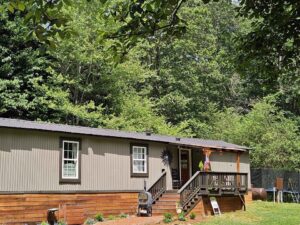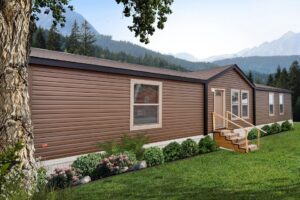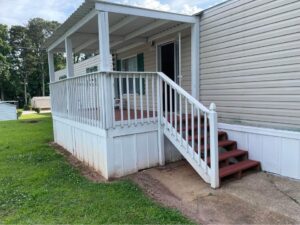Did you know that mobile homes are particularly vulnerable to earthquake damage? Their lightweight construction makes them more susceptible to the intense shaking caused by earthquakes. Understanding the unique challenges posed by earthquakes for mobile homes is crucial for preparedness and ensuring the safety of both the structure and its occupants.
Protecting Mobile Homes from Earthquakes
There have been notable events like the Northridge earthquake and the recent Ridgecrest earthquakes that have highlighted the need for improved safety measures in mobile homes. To address this concern, experts have developed earthquake-resistant bracing systems and established model manufactured home installation standards.

Understanding the Seismic Vulnerability of Mobile Homes
Mobile homes, also known as manufactured homes, are a popular housing option due to their affordability and flexibility. However, these housing units have certain vulnerabilities that can make them more susceptible to earthquake damage.
Flexible Foundations
One key factor contributing to the seismic vulnerability of mobile homes is their flexible foundations. Unlike traditional houses built on concrete slabs or basements, mobile homes are typically placed on lightweight supports such as steel frames or concrete piers. While this allows for easy relocation and installation, it also means that the foundation lacks the rigidity needed to withstand seismic forces.
During an earthquake, the ground shakes back and forth with tremendous energy. This movement exerts strong lateral forces on structures. The flexible nature of mobile home foundations amplifies these forces, causing excessive swaying and potential structural failure. As a result, mobile homes are more prone to displacement and collapse during seismic events.
Lightweight Construction Materials: Protecting Mobile Homes from Earthquakes
Another aspect that contributes to the vulnerability of mobile homes is the use of lightweight materials in their construction. To ensure mobility and cost-effectiveness, manufacturers often utilize materials like thin metal panels or lightweight composites for walls and roofs. Although these materials provide convenience during transportation, they lack the strength and durability required to resist seismic forces.
During an earthquake, powerful shaking can cause significant stress on the structure of a mobile home. The lightweight construction materials may not be able to withstand this stress effectively, leading to cracks in walls or even complete collapse in extreme cases. These materials offer less resistance against flying debris generated by earthquakes which further increases the risk of damage.
Inadequate Anchoring Systems: Protecting Mobile Homes from Earthquakes
Proper anchoring systems play a crucial role in ensuring structural stability during earthquakes. Unfortunately, many mobile homes lack adequate anchorage mechanisms. This makes them more vulnerable compared to conventional houses that are securely anchored into deep foundations.
Without proper anchoring, mobile homes can easily slide or overturn during seismic events. The lack of stability compromises the overall integrity of the structure and poses a significant risk to occupants. Furthermore, the absence of anchoring systems makes it challenging to retrofit existing mobile homes with additional reinforcements to improve their seismic performance. Anchors simply help to protect mobile homes from earthquakes.
Minimizing Damage and Repair Costs in Earthquakes
Earthquakes can cause significant damage to mobile homes, but there are measures that can be taken to minimize the impact and reduce repair costs. By implementing retrofit measures, conducting regular inspections, and investing in earthquake insurance coverage, homeowners can protect their mobile homes from the devastating effects of seismic events.
Retrofit Measures: Strengthening Your Mobile Home
One effective way to reduce potential damage caused by earthquakes is by implementing earthquake bracing systems. These systems consist of specially designed supports and reinforcements that help distribute seismic forces throughout the structure, minimizing stress on vulnerable areas. By installing earthquake-resistant bracing systems, homeowners can significantly enhance the structural integrity of their mobile homes.
Regular Inspections: Identifying Weak Points
Regular inspections play a crucial role in identifying weak points that require reinforcement. By conducting thorough inspections, homeowners can identify areas prone to damage during earthquakes and take appropriate measures to strengthen them. Inspections should focus on key components such as foundation connections, anchoring systems, and roof-to-wall connections. Reinforcing these critical areas will help prevent structural failure during seismic events.
Investing in Earthquake Insurance Coverage: Mitigating Repair Costs
While retrofitting and regular maintenance are essential for protecting against earthquake damage, it is also crucial to consider the financial aspect. Investing in earthquake insurance coverage can provide homeowners with peace of mind knowing that repair costs associated with seismic events will be covered. This type of insurance typically covers damages caused by earthquakes, including structural repairs and replacement costs for damaged belongings.
In areas prone to earthquakes or regions with a history of past earthquakes, earthquake insurance is highly recommended. It offers financial protection against unexpected repair expenses that may arise due to the unpredictable nature of seismic activity.
By combining retrofit measures with regular inspections and adequate insurance coverage, mobile homeowners can significantly minimize both the physical damage caused by earthquakes and the subsequent repair costs.
Preparing Your Mobile Home for a Disaster
Developing an Emergency Plan: Protecting Mobile Homes from Earthquakes
Being prepared for a disaster is crucial. One of the most important steps you can take is developing an emergency plan that ensures swift actions during an earthquake event. Start by identifying the safest areas within your mobile home where you can take cover during tremors. These areas should be away from windows, heavy furniture, and appliances that could potentially topple over.

Next, establish a communication plan with your family members or neighbors in the mobile home park. Determine how you will contact each other in case of an emergency and designate a meeting point outside the park where everyone can gather if necessary. It’s also wise to have emergency contact numbers readily available and stored in multiple locations within your home.
Securing Heavy Furniture and Appliances
To prevent injuries and property damage during an earthquake, it’s essential to secure heavy furniture and appliances in your mobile home. Start by anchoring large pieces of furniture such as bookshelves, cabinets, or dressers to the walls using brackets or straps specifically designed for this purpose. This will help keep them from toppling over during seismic activity.
Secure any appliances that could pose a risk if they were to shift or fall during an earthquake. Consider using appliance straps or securing them with non-slip pads underneath to prevent movement. Pay particular attention to items like refrigerators, ovens, water heaters, and washing machines.
Creating a Disaster Supply Kit
In any post-earthquake situation, having a well-stocked disaster supply kit is vital for survival. Gather essential items and store them in a designated area of your mobile home where they are easily accessible. Here are some items you should include:
Food and Water: Stock up on non-perishable food items such as canned goods, granola bars, and dry snacks. Remember to include enough water (one gallon per person per day) to last at least three days.
First Aid Kit: Prepare a comprehensive first aid kit that includes bandages, antiseptic ointments, pain relievers, and any necessary prescription medications.
Flashlights and Batteries: Ensure you have multiple flashlights with extra batteries to provide light during power outages.
Emergency Radio: Invest in a battery-powered or hand-crank radio to stay informed about the situation and receive updates from local authorities.
Sanitation Supplies: Pack essential hygiene items such as toilet paper, wet wipes, hand sanitizer, and garbage bags for proper waste disposal.
Remember to periodically check your disaster supply kit and replace any expired items or update it according to your family’s needs.
By following these steps and taking proactive measures, you can better prepare your mobile home for an earthquake or any other disaster that may come your way. Stay vigilant, stay prepared!
Mobile Homes and Earthquakes: Emergency Communications and Lighting
Establishing multiple communication channels is crucial in ensuring effective emergency response capabilities in mobile homes during earthquakes. When disaster strikes, reliable communication can be a lifeline for individuals and communities, enabling them to seek help, coordinate rescue efforts, and stay informed about the situation at hand.
One of the primary communication tools in today’s world is the cell phone. Mobile home residents should ensure they have fully charged cell phones readily available at all times. In addition to cell phones, walkie-talkies can serve as a valuable backup communication option. These devices allow for direct and immediate contact with nearby neighbors or emergency responders when traditional means of communication are disrupted.

However, relying solely on electronic devices can be risky during power outages caused by earthquakes. That’s why it’s essential to have backup power sources in place. Generators or solar-powered chargers provide alternative energy solutions that keep your communication devices operational even when electricity is unavailable. By having these support systems prepared beforehand, you can maintain constant access to emergency services and stay connected with loved ones during critical times.
Protecting Mobile Homes from Earthquakes: Power
In an earthquake scenario where power lines may be damaged or disconnected, having adequate lighting becomes paramount for safety within mobile homes. Battery-operated or hand-cranked emergency lights are essential investments that provide illumination when electricity is unavailable. These lights offer a reliable source of visibility that allows occupants to navigate their surroundings safely and efficiently.
It’s important to consider building codes and regulations specific to your area. Consulting with a licensed contractor who specializes in mobile home construction can provide valuable insights into the necessary safety measures required for seismic events.
Furthermore, staying informed about related information published by local authorities or community organizations is crucial. These publications often contain guidelines on earthquake preparedness specific to mobile homes, including recommendations regarding gas connections, water systems, fire safety measures, and urban development considerations.
Engaging with neighbors within your mobile home community is also beneficial. Establishing a network of mutual support can be invaluable during emergencies. Sharing information, resources, and emergency plans with neighbors fosters a sense of community resilience and ensures that everyone is adequately prepared for earthquakes.
Advantages of Mobile Home Retrofitting
Strengthening Structural Integrity
Retrofitting mobile homes is a crucial step in fortifying their structural integrity against the powerful forces unleashed by earthquakes. By reinforcing foundations, walls, and roofs, these dwellings become significantly more resistant to seismic damage. This proactive approach ensures that mobile homes can better withstand the immense pressure and shaking caused by earthquakes.
Enhanced Resistance to Earthquake Damage
One of the primary benefits of retrofitting is the substantial improvement in resistance to earthquake damage. Reinforcing key components of mobile homes minimizes the risk of structural failure during seismic events. Strengthening techniques such as adding additional support beams, bracing walls, and securing fixtures significantly reduce the vulnerability of these structures to collapse or severe damage.
To illustrate this point further, consider how retrofitting can reinforce specific areas vulnerable to earthquake impact:
Foundations: Strengthening the foundation involves anchoring it securely to prevent shifting or displacement during an earthquake.
Walls: Adding reinforcement materials like plywood or steel panels bolsters wall strength and prevents them from collapsing inward.
Roofs: Installing roof-to-wall connections and reinforcing trusses enhances stability, reducing the chances of roof failure during tremors.
By implementing these retrofitting measures, mobile homes gain a remarkable ability to endure even strong earthquakes without sustaining catastrophic destruction.
Increased Lifespan and Reduced Maintenance Costs
Mobile home retrofitting not only safeguards against immediate earthquake-related damages but also extends their overall lifespan while minimizing long-term maintenance costs. By investing in retrofitting measures upfront, homeowners save money by avoiding costly repairs that may arise from earthquake-induced structural failures.

Furthermore, retrofitting helps mitigate wear and tear on various components over time due to regular usage or exposure to environmental factors. Reinforcing critical elements like foundations, walls, and roofs ensures they remain robust for an extended period—reducing the need for frequent repairs or replacements.
In addition to cost savings, retrofitting also offers peace of mind. Homeowners can rest assured that their mobile homes are better equipped to withstand the unpredictable nature of earthquakes, providing a sense of security for themselves and their loved ones.
To summarize, the advantages of mobile home retrofitting are clear: stronger structural integrity against seismic forces, improved resistance to earthquake damage, and increased lifespan with reduced maintenance costs. By taking proactive measures to fortify these dwellings, homeowners can protect their investment while ensuring the safety and longevity of their mobile homes in earthquake-prone areas.
Eligibility for State Earthquake Retrofit Grants
Mobile homes, like any other type of housing, are vulnerable to the devastating impact of earthquakes. To mitigate this risk, many states have implemented financial assistance programs specifically designed to help mobile homeowners retrofit their properties against seismic activity. These state earthquake retrofit grants offer a lifeline to individuals seeking to safeguard their homes from potential destruction. However, it is important to understand the eligibility criteria and requirements associated with these grants in order to take advantage of this valuable support.
Prioritizing Low-Income Individuals and High-Risk Areas
State earthquake retrofit grants aim to prioritize those who are most vulnerable and at high risk during an earthquake. As such, low-income individuals often receive preference when applying for these grants. The intention behind this prioritization is to ensure that those who may struggle financially are not left unprotected in the face of a seismic event.
High-risk areas prone to earthquakes are given special consideration. States like California, known for its seismic activity, prioritize providing financial assistance for mobile home retrofits in regions such as South Napa where the risk is particularly pronounced.
Documentation and Compliance Requirements
To qualify for state earthquake retrofit grants, proper documentation and compliance with grant requirements are essential. This includes submitting various forms and supporting documents that demonstrate eligibility. While specific documentation may vary depending on the state and program, common requirements include proof of ownership or tenancy of a mobile home, income verification documents (such as tax returns or pay stubs), and evidence of residing in a high-risk area.
Moreover, it is crucial to adhere strictly to all grant requirements throughout the application process. Failure to comply with any stipulated conditions may result in disqualification from receiving financial assistance.
You might be interested in our article: Green Mobile Homes for Living
Key Takeaways on Protecting Mobile Home Earthquake: Preparedness
In conclusion, being prepared for earthquakes is crucial. By understanding their vulnerability and taking necessary precautions, you can minimize damage, ensure your safety, and potentially save on repair costs.
Some key takeaways include:
-
Understanding the Seismic Vulnerability of Mobile Homes: Mobile homes are more susceptible to earthquake damage due to their lightweight construction and lack of foundation. It’s important to recognize this vulnerability and take appropriate measures.
-
Minimizing Damage and Repair Costs in Earthquakes: By securing your mobile home to its foundation, reinforcing walls, and installing seismic bracing systems, you can reduce the risk of structural damage during an earthquake. This proactive approach can save you from costly repairs afterward.
-
Preparing Your Mobile Home for a Disaster: Creating an emergency kit with essential supplies such as food, water, medications, flashlights, and batteries is vital. Having a family emergency plan in place ensures everyone knows what to do in case of an earthquake.
-
Emergency Communications and Lighting: Establishing alternative communication methods like walkie-talkies or satellite phones can be invaluable during emergencies when traditional means may not be available. Adequate lighting sources such as battery-powered lanterns or glow sticks should also be readily accessible.
-
Advantages of Mobile Home Retrofitting: Retrofitting your mobile home with seismic upgrades significantly improves its resistance to earthquakes. This investment enhances both the safety of occupants and the integrity of the structure.
-
Eligibility for State Earthquake Retrofit Grants: Some states offer financial assistance through retrofit grants for homeowners looking to strengthen their mobile homes against earthquakes. Researching eligibility criteria and applying for these grants can help offset the costs associated with retrofitting.
Remember that preparedness is key. Taking action now can make a significant difference in protecting your home and loved ones in the face of seismic events.
FAQs: Protecting Mobile Homes from Earthquakes
Can I retrofit my mobile home myself?
While some minor retrofitting tasks can be done by homeowners, it is recommended to consult with professionals who specialize in mobile home earthquake retrofitting for more complex projects. They have the expertise to ensure the job is done correctly and up to code.
Are there any government programs that provide financial assistance for mobile home earthquake retrofitting?
Yes, certain states offer earthquake retrofit grants specifically designed to help eligible homeowners cover the costs of strengthening their mobile homes against earthquakes. Researching your state’s programs and requirements is essential to determine if you qualify for such assistance.
How often should I inspect my mobile home for potential earthquake vulnerabilities?
It is advisable to conduct regular inspections at least once a year or after any significant seismic event. This allows you to identify any damage or areas that require reinforcement promptly.
Can insurance cover damages caused by earthquakes for mobile homes?
Standard homeowner’s insurance policies usually do not cover earthquake damage. However, you may consider purchasing separate earthquake insurance coverage specifically tailored for mobile homes.
What should I do during an earthquake if I am inside my mobile home?
Seek shelter under a sturdy piece of furniture away from windows, exterior walls, and heavy objects that could potentially fall. Stay indoors until the shaking stops and follow your emergency plan accordingly.
Remember, being prepared can save lives and protect your property during an earthquake. Stay informed, take necessary precautions, and prioritize safety above all else.
You might be interested in our articles:

